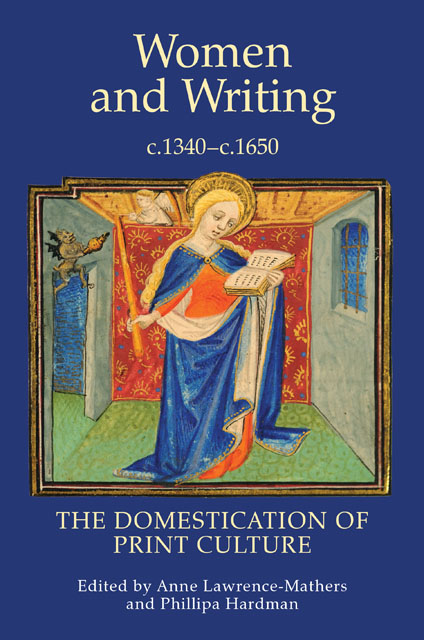Book contents
- Frontmatter
- Contents
- List of Plates
- List of Contributors
- Abbreviations
- Introduction
- Domestic Learning and Teaching: Investigating Evidence for the Role of ‘Household Miscellanies’ in Late-Medieval England
- Domesticating the Calendar: The Hours and the Almanac in Tudor England
- ‘a briefe and plaine declaration’: Lady Anne Bacon’s 1564 Translation of the Apologia Ecclesiae Anglicanae
- Frances Wolfreston’s Chaucer
- Commonplace Book Culture: A List of Sixteen Traits
- Women, Politics and Domesticity: The Scribal Publication of Lady Rich’s Letter to Elizabeth I
- ‘yr scribe can proove no nessecarye consiquence for you’?: The Social and Linguistic Implications of Joan Thynne’s using a Scribe in Letters to her Son, 1607–11
- Fathers and Daughters: Four Women and Their Family Albums of Verse
- The Book as Domestic Gift: Bodleian MS Don. C. 24
- ‘like hewen stone’: Augustine, Audience and Revision in Elizabeth Isham’s ‘Booke of Rememberance’ (c. 1639)
- Female Voices in Early Seventeenth Century Pamphlet Literature
- Select bibliography
- Index
- Misscellanious Endmatter
‘like hewen stone’: Augustine, Audience and Revision in Elizabeth Isham’s ‘Booke of Rememberance’ (c. 1639)
Published online by Cambridge University Press: 01 March 2023
- Frontmatter
- Contents
- List of Plates
- List of Contributors
- Abbreviations
- Introduction
- Domestic Learning and Teaching: Investigating Evidence for the Role of ‘Household Miscellanies’ in Late-Medieval England
- Domesticating the Calendar: The Hours and the Almanac in Tudor England
- ‘a briefe and plaine declaration’: Lady Anne Bacon’s 1564 Translation of the Apologia Ecclesiae Anglicanae
- Frances Wolfreston’s Chaucer
- Commonplace Book Culture: A List of Sixteen Traits
- Women, Politics and Domesticity: The Scribal Publication of Lady Rich’s Letter to Elizabeth I
- ‘yr scribe can proove no nessecarye consiquence for you’?: The Social and Linguistic Implications of Joan Thynne’s using a Scribe in Letters to her Son, 1607–11
- Fathers and Daughters: Four Women and Their Family Albums of Verse
- The Book as Domestic Gift: Bodleian MS Don. C. 24
- ‘like hewen stone’: Augustine, Audience and Revision in Elizabeth Isham’s ‘Booke of Rememberance’ (c. 1639)
- Female Voices in Early Seventeenth Century Pamphlet Literature
- Select bibliography
- Index
- Misscellanious Endmatter
Summary
Early in her autobiographical ‘Booke of Rememberance’, Elizabeth Isham writes: ‘I would not offer that to the Lord my God which doth cost me nothing but like hewen stone I have prepared this in all points as true as I could.’ She presents her narrative as a ‘true’ account of her own life and emphasizes the effort expended in revealing that truth, later adding that the ‘cost’ of the labour that went into her task was summoned from both ‘soule’ and ‘body’. Like ‘hewen stone’ that has been carved and polished, her text has been crafted from the raw material of her life, a feat requiring both physical and spiritual effort and stamina. Isham’s description is made particularly striking because in the Bible ‘hewn stone’ is cited as a negative thing; for example, Exodus 20. 25: ‘And if thou wilt make me an altar of stone, thou shalt not build it of hewn stone: for if thou lift up thy tool upon it, thou hast polluted it.’ In this context, stone that is hewn is engraved, beautified and defaced by a process of human craft that obscures its natural God-given form. But for Isham, the act of hewing her text is a means not of adorning it but of purifying it. It allows her to pare away the dross to achieve a more rarefied form of truth. Her volume as a whole suggests that for her much of the value of the text resides not solely in its completed form but in the work, both spiritual and physical, expended in its creation. Some indication of the work Isham put into the production of her autobiographical narrative is provided by a comparison of the fair-copy text now in Princeton with a series of draft sections fortuitously preserved in Northamptonshire Record Office. Such a comparison sheds light both on the careful way in which Isham constructed her narrative and on the spiritual significance invested in the process of composition.
In her own words, Elizabeth Isham was ‘borne immediatly afore day the 28 of January … in the yere of our lord 16[0]9’. She was born at the family residence Lamport Hall in Northamptonshire and was the daughter of Sir John Isham, first baronet and his wife Judith.
- Type
- Chapter
- Information
- Women and Writing, c. 1340-c. 1650The Domestication of Print Culture, pp. 177 - 195Publisher: Boydell & BrewerPrint publication year: 2010
- 4
- Cited by



